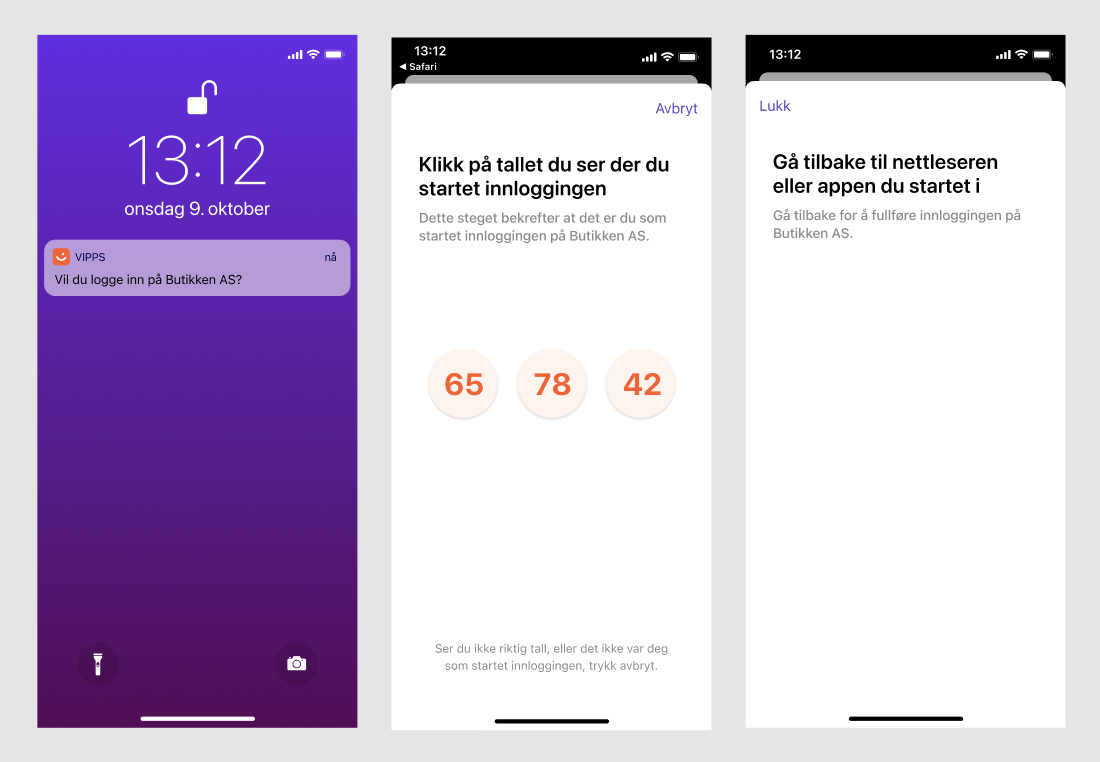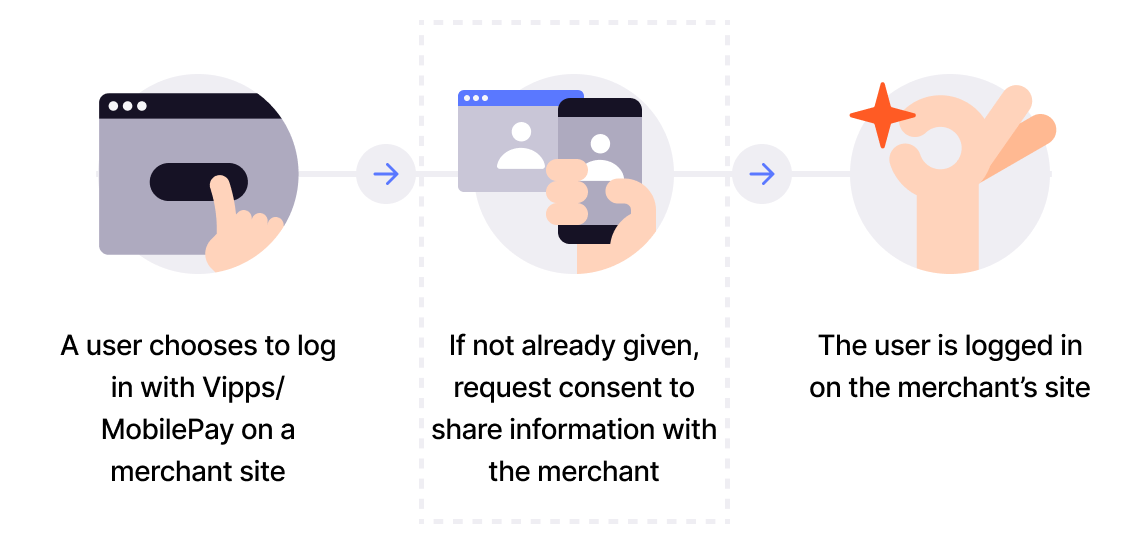Login from a website
API version: 2.0
In the Login from a website flow, the user initiates their first login by entering their phone number on the landing page. They select whether to be remembered in the browser and then give consent to sharing their information with the merchant, if needed.
Here is the customer experience for their first login:

From the website, they will see screens similar to these:

Then, they will go to the Vipps or MobilePay app and confirms the login:

They are authenticated in the browser and can provide consent, if required.
Then the user can be redirected back to the redirect URI, if provided by merchant:

For an extended illustration of this sequence, see How it works: Login from a website.
Remembered flow
The user can choose to be remembered in the browser, enabling automatic sign-ins for later visits. If a user has chosen to be remembered in browser, then they don't need to go to the app.
The user will either be asked to provide consent to share profile information or be logged in directly.

If the user is remembered in browser, then only the consent flow will be completed. If the user already has provided consent, then this step will be skipped also, allowing a direct login experience.
This is a key feature of the service and can't be disabled by merchants without special permission. This means that it is not possible to set up Login as a two-factor authentication (2FA).
Plugins
For Login from a website, there are Vipps MobilePay plugins available for several platforms. For instance:
- Login module for Adobe Commerce / Magento
- Vipps Login for Drupal
- Vipps Login for ASP.NET and Optimizely
- Vipps/MobilePay Login for WordPress and WooCommerce
To get help with this from a partner, go to Find a partner.
Manual integration
This section contains information necessary to perform a manual integration with Login. This should not be attempted without a solid grasp of the OAuth2 and OpenID Connect standards. All endpoints needed for integration can be found in our OpenID connect discovery endpoint. These endpoints should be fetched dynamically by your application, since they are prone for change.
If a plugin is not available, the easiest - and strongly recommended - way to integrate with the service is to use a well renowned OAuth2.0/OpenID Connect Library for your programming language.
We don't recommend any specific library, but the certified OpenID developer tools page is a good starting point.
Login in browser should only be run in the browser window using redirects. iFrame is not supported, and new window is not recommended.
Call by call
The following is a very basic case, starting with a user clicking Log in with Vipps/MobilePay until the merchant receives login token and the user's information:
-
Before all this, the merchant has fetched the OpenID configuration from the well-known endpoint and cached it.
See .well-known.
-
The merchant initiates a login by calling the
authorization_endpointfrom .well-known.GET {authorization_endpoint}?client_id={client_id}&response_type=code&scope={scopes}&state={state}&redirect_uri={redirect_uri} -
This will bring the user to the Vipps or MobilePay login screen, where they will consent to sharing information with the merchant. After consenting, the browser is redirected to the
redirect_urisupplied by the merchant.{redirect_uri}?code={code}&state={state}&scope={scopes} -
The merchant uses the
code-parameter to obtain the login token.POST {token_endpoint}withcode={code},grant_type=authorization_code, andredirect_uri={redirect_uri}in theapplication/x-www-form-urlencoded-body. This returns (amongst others) anaccess_tokenthat can be used to fetch userinfo.See Token endpoint.
-
To obtain userinfo, the merchant must do a GET to the
userinfo_endpointwith the header:Authorization: Bearer {access_token}. This returns the information the user consented to sharing.See Userinfo.
Endpoints
OpenID connect discovery endpoint
| Environment | Base URL |
|---|---|
| Test | https://apitest.vipps.no/access-management-1.0/access/.well-known/openid-configuration |
| Production | https://api.vipps.no/access-management-1.0/access/.well-known/openid-configuration |
The OpenID connect discovery endpoint can be used to retrieve configuration information for OpenID connect clients.
We recommend fetching these dynamically, however the response from this endpoint rarely changes.
Therefore, it can and should be cached, so it's not fetched over the network on every login. The endpoint responds with a Cache-Control: max-age=3600 header.
You can learn more at the OIDC Standard.
Request:
GET:/access-management-1.0/access/.well-known/openid-configuration
Response:
Overview
| HTTP status | Description |
|---|---|
200 OK | Request successful. |
500 Server Error | An internal Vipps MobilePay problem. |
Example response from the merchant test environment:
{
"issuer": "https://apitest.vipps.no/access-management-1.0/access/",
"authorization_endpoint": "https://apitest.vipps.no/access-management-1.0/access/oauth2/auth",
"token_endpoint": "https://apitest.vipps.no/access-management-1.0/access/oauth2/token",
"jwks_uri": "https://apitest.vipps.no/access-management-1.0/access/.well-known/jwks.json",
"subject_types_supported": [
"public",
"pairwise"
],
"response_types_supported": [
"code",
"code id_token",
"id_token",
"token id_token",
"token",
"token id_token code"
],
"claims_supported": [
"sub"
],
"grant_types_supported": [
"authorization_code",
"implicit",
"client_credentials",
"refresh_token"
],
"response_modes_supported": [
"query",
"fragment"
],
"userinfo_endpoint": "https://apitest.vipps.no/vipps-userinfo-api/userinfo",
"scopes_supported": [
"openid",
"address",
"name",
"email",
"phoneNumber",
"nin",
"birthDate",
],
"token_endpoint_auth_methods_supported": [
"client_secret_post",
"client_secret_basic",
"private_key_jwt",
"none"
],
"userinfo_signing_alg_values_supported": [
"none",
"RS256"
],
"id_token_signing_alg_values_supported": [
"RS256"
],
"request_parameter_supported": true,
"request_uri_parameter_supported": true,
"require_request_uri_registration": true,
"claims_parameter_supported": false,
"revocation_endpoint": "https://apitest.vipps.no/access-management-1.0/access/oauth2/revoke",
"backchannel_logout_supported": false,
"backchannel_logout_session_supported": false,
"frontchannel_logout_supported": false,
"frontchannel_logout_session_supported": false,
"end_session_endpoint": "https://apitest.vipps.no/access-management-1.0/access/oauth2/sessions/logout"
}
OpenID connect discovery URLs
| Operation | Description | Endpoints |
|---|---|---|
| OAuth 2.0 authorize | Start an OAuth 2.0 authorization. | GET:/access-management-1.0/access/oauth2/auth |
| OAuth 2.0 token | Get an OAuth 2.0 access token. | POST:/access-management-1.0/access/oauth2/token |
| Userinfo | Returns information that the user has consented to share. | GET:/vipps-userinfo-api/userinfo |
| JSON web keys discovery | Get JSON web keys to be used as public keys for verifying OpenID Connect ID Tokens. | GET:/.well-known/jwks.json |
OAuth 2.0 authorize
The authorize endpoint is a standard OIDC endpoint used for starting an
authorization. The client creates a request URI and directs the resource owner
to the constructed URI.
Request:
The client constructs the request URI by adding the following parameters to the
query component of the authorization endpoint URI using the
application/x-www-form-urlencoded format. The client directs the resource
owner to the constructed URI using an HTTP redirection response, or by other
means available to it via the user-agent.
| Query | Description | Required/Optional | Example |
|---|---|---|---|
response_type | Value MUST be set to code. | Required | code |
client_id | The client identifier, issued by Vipps MobilePay. | Required | 123456-test-client-id |
redirect_uri | Redirect URI which the user agent is redirected to after finishing a login. Recommend to use universal links (Apple)/Asset links (Android), such as https://example.com/app/callback. If the URI is using a custom URL scheme, a path is required: myapp://path-to-something. See API endpoints required from the merchant. | Required | https://example.com/app/callback |
scope | Scope of the access request, space-separated list. | Required | openid email phoneNumber |
state | An opaque value (e.g. a GUID) used by the client to maintain state between the request and callback. The authorization server includes this value when redirecting the user-agent back to the client. It must be at least 8 characters long to ensure sufficient entropy. In case of a too short state parameter the end-user will be redirected back to the merchant's site with an error. | Required | 123e4567-e89b-12d3-a456-426614174000 |
requested_flow | Request a specific flow for the user. See Login from a mobile app. | Optional | app_to_app or app_to_app_v2 |
market | Supported values: NO, DK, FI, SE. The market where the Login integration is used helps us decide whether the Login client should appear with a Vipps  theme (for Norway and Sweden) or MobilePay theme (for Norway and Sweden) or MobilePay  theme (for Denmark and Finland). theme (for Denmark and Finland). | Optional | NO results in Vipps theme |
app_callback_uri | The target URI for automatic switch back to merchant app. Requires requested_flow=app_to_app or requested_flow=app_to_app_v2. | Optional | https://example.com/app/callback |
final_redirect_is_app | Either true or false. If this is true we will enable some compatibility features to make sure the user is returned to the app. | Optional | true |
code_challenge_method | Used for PKCE, either S256 or plain. Default value is plain. | Optional | S256 |
code_challenge | Used for PKCE. The value must be calculated based on the code_verifier later used towards the token endpoint. | Optional | E9Melhoa2OwvFrEMTJguCHaoeK1t8URWbuGJSstw-cM |
step_up | Always asks for the user to authenticate. Avoids users being remembered in the browser. Access to this setting is currently handled on a case-by-case basis. Please contact us for further information. | Optional | true |
For example, the client directs the user-agent to make the following HTTP request:
You can test this by entering the URL into any browser. This will initiate the log in sequence.
See the step-by-step instructions in the quick start guide.
URIs specified on portal.vippsmobilepay.com
must be exactly the same as used in the API calls. Be extra careful with
trailing / and URL-encoded entities. If the URIs are not identical you will get
this error:
The provided authorization grant (e.g., authorization code, resource owner credentials) or refresh token is invalid, expired, revoked, does not match the redirection URI used in the authorization request, or was issued to another client
Response:
If the resource owner grants the access request, the authorization server issues
an authorization code and delivers it to the client by adding the following
parameters to the query component of the redirection URI using the
application/x-www-form-urlencoded format.
| Query | Description |
|---|---|
code | The authorization code generated by the authorization server. This code should be sent with the subsequent /token request. The client MUST NOT use the authorization code more than once. The authorization code is bound to the client identifier and redirect URI. |
state | The exact value received from the client during the authorization request. |
scope | The scopes that the end user has consented to. This list will always be the same as in the request query as end users are not allowed to remove individual scopes when they give consent. |
For example, the authorization server redirects the user-agent by sending the following HTTP response:
HTTP/1.1 302 Found
Location: https://example.com/callback?code={code}&state={state}&scope={scopes}
If the resource owner declines the access request, or an error occurs, the authorization server adds the following parameters to the query component of the
redirection URI using the application/x-www-form-urlencoded format. More details in Error handling
For more general information see the standard specifications OpenID Connect Core 1.0 and RFC-6749 section 4.1.1-4.1.2.
OAuth 2.0 token
The token endpoint is a standard OIDC endpoint used for requesting Access and
ID Tokens. The client constructs the request by adding the parameters described
below to the HTTP body by using the application/x-www-form-urlencoded format.
Request:
Headers
| Header | Description |
|---|---|
Content-Type | application/x-www-form-urlencoded |
Authorization | Basic {Client Credentials} |
The Client Credentials is a base 64 encoded string consisting of the client_id
and secret issued by Vipps MobilePay joined by :.
Example in JavaScript:
var client_id = 123456-test-4a3d-a47c-412136fd0871
var client_secret = testdzlJbUZaM1lqODlnUUtrUHI=
var wordArrayAzp = CryptoJS.enc.Utf8.parse(client_id + ":" + client_secret);
var client_credentials = CryptoJS.enc.Base64.stringify(wordArrayAzp);
Form content:
| Key | Description |
|---|---|
grant_type | Value MUST be authorization_code. |
code | The authorization code received as a query parameter on the redirect_uri from the authorization server. |
redirect_uri | Redirect URI which the user agent is redirected to after finishing a login. Recommend to use universal links (Apple)/Asset links (Android), such as https://example.com/app/callback. If the URI is using a custom URL scheme, a path is required: myapp://path-to-something. See API endpoints required from the merchant. This field is required for OIDC flows, i.e. regular Vipps MobilePay logins. |
POST:/access-management-1.0/access/oauth2/token
Response:
| HTTP status | Description |
|---|---|
200 OK | Request successful. |
401 Unauthorized | Invalid credentials. |
500 Server Error | An internal Vipps MobilePay problem. |
Example response:
{
"access_token": "hel39XaKjGH5tkCvIENGPNbsSHz1DLKluOat4qP-A4.WyV61hCK1E2snVs1aOvjOWZOXOayZad0K-Qfo3lLzus",
"id_token": "eyJhbGciOiJSUzI1NiIsImtpZCI6InB1YmxpYzo4MGYzYzM0YS05Nzc5LTRlMWUtYjY0NS0xMTdmM2I3NzFhZjgiLCJ0eXAiOiJKV1QifQ.eyJhdF9oYXNoIjoidHlGbkgyMFRPbVBaa2dKVThlNWlLdyIsImF1ZCI6WyJ2aXBwcy1pbnRlZ3JhdGlvbiJdLCJhdXRoX3RpbWUiOjE1NTczMTkyOTYsImV4cCI6MTU1NzMyMjkzOCwiaWF0IjoxNTU3MzE5MzM4LCJpc3MiOiJodHRwczovL2FwaXRlc3QudmlwcHMubm8vYWNjZXNzLW1hbmFnZW1lbnQtMS4wL2FjY2Vzcy8iLCJqdGkiOiI2MmE4NWU1Ni0zZDQ1LTRjN2UtYTA1NS00NjkzMjA5MzI1N2EiLCJub25jZSI6IiIsInJhdCI6MTU1NzMxOTI1NSwic3ViIjoiYzA2YzRhZmUtZDllMS00YzVkLTkzOWEtMTc3ZDc1MmEwOTQ0In0.OljG0W_TCfxkrRntj_5He3U0PH94SDZvlK-dvUJe8H5jj8QSiSnqiv65kyzxdr8Bq1MwG7a6Mtlnn4MoL8AyxKUVe6s81CNaYmwaHsWLw2Z2JmiPn5_X4lEy1nHVDX3R7lFKDQqFLSGnGNPU9bACj-Si18LBR-qv060wEj3b1ShrVeUIZCL1Yhxb6cIGl_8RivRto9dBrzggyOlVTtmoPrm9TLYF7UGWjlbmHTqpBWsCQIOeQqgs7RmSBt5k3O9nmP7guVxo5MWv_2Z0XuCqobLDDXJ29Rk_W6d79y-lPzq_TedNb_lCdVJF7u9qDYFbIPuQwXp26CeIJcR-nc-t0qEoNmLru_x-9Z8dCjjzkZbWqyNsNedQU1zt0WFbHjRkodVoHNcRZVT5W5hCe54lmZ6lUqyKwHW0_3Rpd2CI6lPdCOhC-Tze5cUDfb8jT_0OZqCI_wAuWvb6_4VeHqhvUav6Mh6d7AxNJQYG6BAJo9TzyrG7ho4mSpb2wWMr8gmRi8pTQbqa40whPqptpiz_j4AHcsrRckjYONU0USKlnNcBGc24M4sprcLZ6vxFqDYmDoZwUDRdZWRpUbqm_nCmCKb20Z6l5O7h32KvOApopJe2NIeAynli3Nl05QVGOdoT1mZDLYXbtyb0b_4qhRflySr6gaczcf2ovUKAToKNs_4",
"expires_in": 3599,
"scope": "openid",
"token_type": "bearer"
}
Userinfo
The GET:/vipps-userinfo-api/userinfo endpoint returns the payload with the information that the user has consented to share, which is provided in
the OAuth 2.0 access token.
You can learn more at OIDC Standard.
Request:
Headers:
| Header | Description |
|---|---|
| Authorization | Bearer {Access Token} |
The access token is received on a successful request to the token endpoint.
GET:/vipps-userinfo-api/userinfo
Response:
Overview
| HTTP status | Description |
|---|---|
200 OK | Request successful. |
401 Unauthorized | Invalid credentials. |
500 Server Error | An internal Vipps MobilePay problem. |
Standard example response
{
"sub": "c06c4afe-d9e1-4c5d-939a-177d752a0944",
"birthdate": "1815-12-10",
"email": "user@example.com",
"email_verified": true,
"nin": "10121550047",
"name": "Ada Lovelace",
"given_name": "Ada",
"family_name": "Lovelace",
"sid": "7d78a726-af92-499e-b857-de263ef9a969",
"phone_number": "4712345678",
"address": {
"street_address": "Suburbia 23",
"postal_code": "2101",
"region": "OSLO",
"country": "NO",
"formatted": "Suburbia 23\\n2101 OSLO\\nNO",
"address_type": "home"
},
"other_addresses": [
{
"street_address": "Fancy Office Street 2",
"postal_code": "0218",
"region": "OSLO",
"country": "NO",
"formatted": "Fancy Office Street 2\\n0218 OSLO\\nNO",
"address_type": "work"
},
{
"street_address": "Summer House Lane 14",
"postal_code": "1452",
"region": "OSLO",
"country": "NO",
"formatted": "Summer House Lane 14\\n1452 OSLO\\nNO",
"address_type": "other"
}
]
}
JSON web keys Discovery
This endpoint returns JSON Web Keys to be used as public keys for verifying OpenID Connect ID Tokens.
Request:
GET:/access-management-1.0/access/.well-known/jwks.json
Response:
Overview
| HTTP status | Description |
|---|---|
200 OK | Request successful. |
500 Server Error | An internal Vipps MobilePay problem. |
Examples: 200 response
{
"keys": [
{
"use": "sig",
"kty": "RSA",
"kid": "public:80f3c34a-9779-4e1e-b645-117f3b771af8",
"alg": "RS256",
"n": "n4kytA_ZeI3Znl96b-zteWmrSHjRmXnvLmACQ4W_BVRTtuhumuoLpOpavUcEOhajbLKqBrANC0dd7ABtL92gHRoVRp8VMSNBG6ykuD04gevxqgm2Gz1mGineWBrjINwY-WboPMqgyZLLKw-JjZ6EqHm67TnWxrKjk3135tGILWvrTJ6ykglGpfH0jpGtEOS6VUuSWeW5VitEGeOFDwWja4mYXZbfGICtKnD6LZOM8sFKyC9diBmDXuXZvxdwdBfVh9JvWMaZ5bJ_mv4iJ0qU0FM1yginRMLXY3MOxwLSLSQjmDPV8NZecUsK-UEfpJl7lvLdEFqKCdqQxkEEyLPMq_rM50F5QIbKa0BYoa973-OR9cJ-XQkLNCtF5i003Z3V-5c7N3xBNlpGYsp4CCvv--zFpxvRZ0k-axgu1Loj1eOZRuX1DL86iTQ6YXcBGPYlRkRNJOn7mkRV8wn8kp_DMlzJ7bgE-NFEA32wFrEimPCrGUfdNdjn6gMsWKcbiHiM4NlIDrCNPiD2CVPrHGuVex8R0cpKU0Cvxc8mXqvDc-VJbrqrRNPbZJh0Zoz4wfK9LESdYGAah9PhgHg5LDFHmhT0W3FPmy1Gmfk2ino4PryJ_rDXe0WT84IEGV9YEM631gDerS63D1dKvTP01YT5sd2Ymn9eptH9grvFeOhuvz0",
"e": "AQAB"
}
]
}
This operation does not require authentication.
API endpoints required from the merchant
The following endpoints are to be implemented by merchants, in order for us to redirect the resource owner to them.
Receive authentication result
After a successful authentication, the user agent is redirected to this endpoint with the following parameters added to the query component. This URI must be pre-registered with us, and it must be supplied as a query parameter on calls to the OAuth2 authorize endpoint.
| Parameter | Description |
|---|---|
code | The authorization code generated by the authorization server. The client MUST NOT use the authorization code more than once. The authorization code is bound to the client identifier and redirection URI. |
state | The exact value received from the client during the authorization request. |
Example:
HTTP/1.1 302 Found
Location: https://example.com/callback?code={code}&state={state}
Error handling
If the user cancels the login or an error occurs, the user agent is redirected to the authentication result endpoint with the following parameters added to the query component.
| Parameter | Description |
|---|---|
error | Standard OAuth2 or OIDC error code. |
error_description | A short text providing additional information on the error that occurred. |
state | The exact value received from the client during the authorization request. |
Custom error codes
In addition to the standard errors defined in OAuth2 and OIDC, Login also has some custom error codes that you might see on the redirect:
| error_code | Description |
|---|---|
access_denied | User cancelled the login |
server_error | Something went wrong, please try again |
login_required | User must log in with interaction |
invalid_app_callback_uri | The app callback URI is not on a valid format |
app_callback_uri_not_registered | The app callback URI is not registered as a redirect URI |
outdated_app_version | The user's Vipps or MobilePay app version is too old and needs to be updated |
wrong_challenge | The user selected the wrong challenge |
unknown_reject_reason | Something went wrong. Reject reason is unknown. |
There may be other errors, so integrators must be able to handle undocumented errors gracefully.
Example:
HTTP/1.1 302 Found
Location: https://example.com/callback?error=access_denied&error_description=user%20cancelled%20the%20login?state={state}
If a fatal error occurs where the user can't be redirected back to the merchant, a generic Vipps or MobilePay styled error page will be shown containing a brief error description.
Browser flow marketing consents
The merchant may choose to include the delegatedConsents scope to collect consents from the user.
If the scope is included in the request, the user will be asked to give consents according to merchant specifications. In the browser flow this happens only on the first login.
- Configure the marketing consents.
- Follow the call by call guide, but with the addition of the
delegatedConsentsscope in the initial request. This will prompt the user to give consent to the merchant's marketing consents. - The first time the user logs in the userinfo response will contain the user's consent status on the format shown in the Userinfo response example.
- Later logins will not prompt the user for consent again or contain data on the userinfo response, unless the merchant re-configures marketing consents in the merchant portal.
Marketing consents are remembered for the user, so they only need to approve them once. This means that if the user has already approved the consents, they will not see the screen again. You can configure that previously consented users review and consent to new terms through the merchant portal when you save a new Marketing consents configuration.
Example response with marketing consents
Note the delegatedConsents object will only be present on the first login.
{
"family_name": "Heyerdahl",
"given_name": "Tor Fos",
"name": "Tor Fos Heyerdahl",
"other_addresses": [],
"sid": "qwieuhwqiuhdiuwqh",
"sub": "f350ef33-22e2-47d0-9f47-12345667",
"delegatedConsents" : {
"language" : "EN",
"heading" : "Give consent",
"termsDescription" : "By confirming, you accept oidc-testclient's terms of membership. They are responsible for processing the consents. You can withdraw them at any time on their website.",
"confirmConsentButtonText" : "Confirm",
"links" : {
"termsLinkText" : "Read the terms of use.",
"termsLinkUrl" : "http://vippsmobilepay.com/legal/terms-and-conditions",
"privacyStatementLinkText" : "Read the privacy policy.",
"privacyStatementLinkUrl" : "https://vippsmobilepay.com/terms-privacy"
},
"timeOfConsent" : "2022-11-23T11:40:13Z",
"consents" : [ {
"id" : "email",
"accepted" : true,
"required" : true,
"textDisplayedToUser" : "Receive offers via email"
}, {
"id" : "sms",
"accepted" : true,
"required" : false,
"textDisplayedToUser" : "Receive offers via SMS"
}, {
"id" : "digital",
"accepted" : true,
"required" : false,
"textDisplayedToUser" : "I would like to receive digital marketing"
}, {
"id" : "personal",
"accepted" : true,
"required" : false,
"textDisplayedToUser" : "Get customized offers"
} ]
}
}